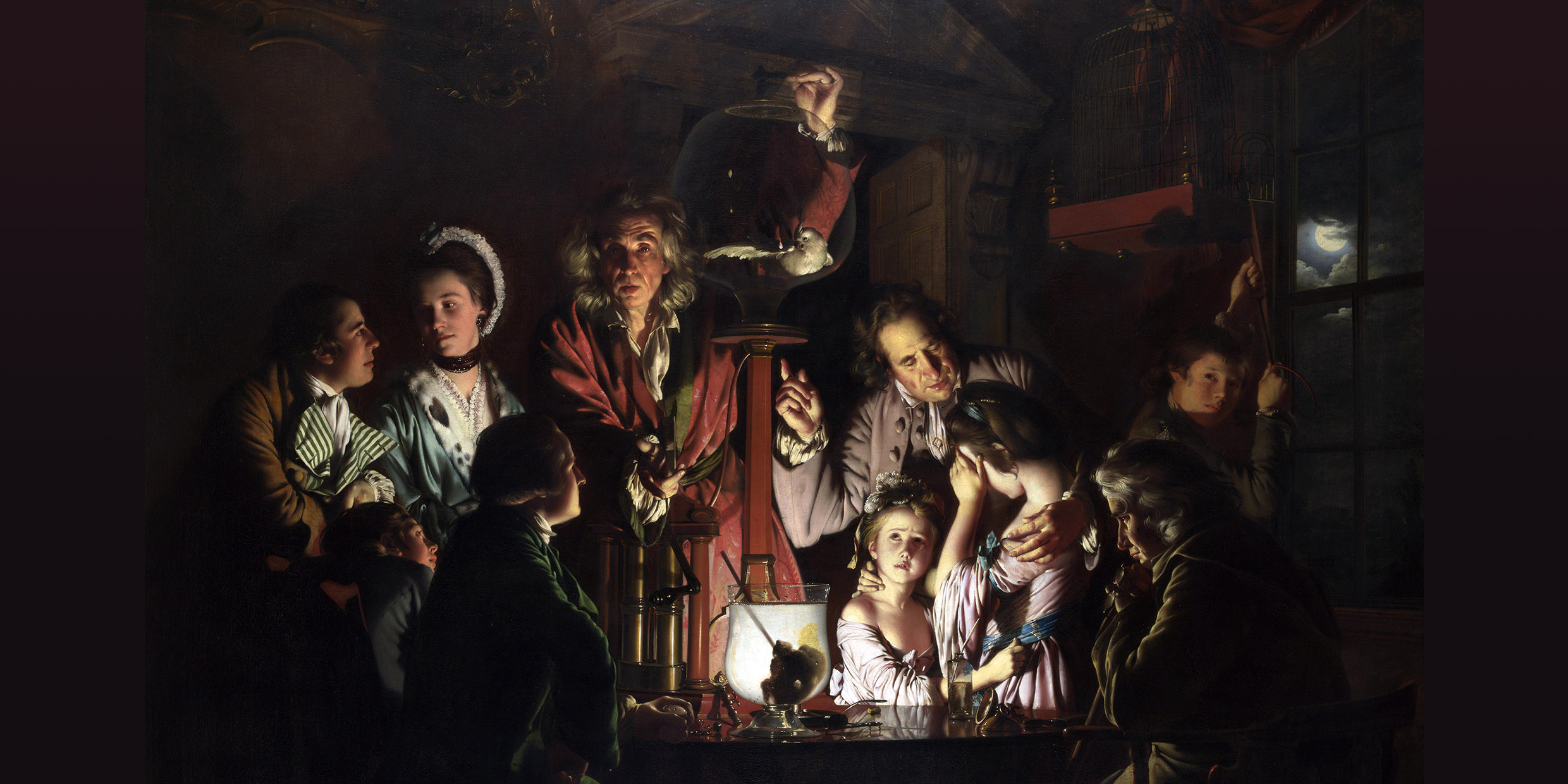Originally published 3 September 1990
On Thursday of this week [in 1990] the Metropolitan Museum of Art in New York will open a show of the works of the 18th century painter Joseph Wright of Derby. The show had its origin at the Tate Gallery, London, and moved on to Paris before arriving here.
Wright is a secondary figure in the history of British art, overshadowed now as in his own time by such giants as Reynolds and Gainsborough. But two of his paintings, especially, secure his place in the history of art: A Philosopher Giving a Lecture on the Orrery, and An Experiment on a Bird in the Air Pump.
The paintings are significant in British art for their use of indirect artificial illumination. In The Orrery (an orrery is a model solar system) the illuminating candle is hidden behind a spectator; in The Air Pump the light source is obscured by a liquid-filled jar. In both paintings, we see the light reflected in the faces of the spectators and in the gleaming brass, wood, and glass of the scientific equipment being demonstrated.
A Victorian look
The paintings combine realism and romanticism in a way that anticipates much of 19th century art. The Air Pump, for example, is dated 1768, but has the look of a Victorian set piece from a century later.
The paintings are also important documents in the history of science. They visually capture the moment when two centuries of revolutionary scientific achievement gave birth to modern technological civilization.
In The Air Pump, a natural philosopher demonstrates the properties of the vacuum to a small middle-class audience of adults and children. The vacuum is produced by a hand-operated pump. The two halves of a Magdeburg sphere lie on the table, suggesting that the force of air pressure has already been demonstrated. In this classic experiment, the halves of the sphere are placed together without being mechanically connected in any way, like two cupped hands. The air inside is evacuated and then someone in the audience is invited to pull the halves apart. The sphere is held tightly closed by the pressure of the air outside.
Now it is time to observe life’s vital need of air. A white bird, a cockatoo, has been placed in a glass globe, and the globe evacuated. The bird falters. We are admitted to the scene at the moment when the bird will either expire or be allowed to revive by the compassion of the demonstrator — whose hand is delicately poised on the valve that will re-admit the air.
The demonstrator has the piercing eyes, disarrayed hair, and demonic stare of the arch-magician. He looks straight out of the picture, inviting us into his audience, as if saying, “Look, by my knowledge of the secrets of nature I possess the God-like power to withdraw life or to restore it.” This central figure of Wright’s painting bears a striking resemblance to Isaac Newton, whose commanding achievements continued to dominate British science even in Wright’s time, a half-century after the great physicist’s death.
To the right of the apparatus, a gentleman of the newly-prosperous English midlands urges his daughters to look and be edified by the experiment. Frightened, they turn away from the bird’s plight. This earnest father might be taken to represent Josiah Wedgewood, ceramics manufacturer, or Erasmus Darwin, physician and grandfather of Charles Darwin, or any of the other members of the Lunar Society, a group of curious, inventive men who came together each month in Birmingham on the night of the full moon, when travel over rough and dangerous roads was made relatively safer by moonlight.
The group included Joseph Priestly, the discoverer of oxygen, John Wilkinson, ironmaker, John Baskerville, printer, William Small, astronomer, Benjamin Franklin, diplomat and physicist, and James Brindley, civil engineer. Together they considered the potential of science for transforming society. These were the men who made the Industrial Revolution. They were Joseph Wright’s patrons, and not by chance did the artist of The Air Pump place a full moon outside the window.
At the left of the painting, three young men watch in rapt fascination as the natural philosopher manipulates the very air we breathe (one of them is timing the bird’s struggle with a pocket watch). It is not hard to imagine among these curious onlookers James Watt, perfecter of the steam engine, who understood better than anyone else the potential of air and vacuum to drive machinery, or Mathew Boulton, his entrepreneurial partner.
The Watt-Boulton engine, which appeared in 1776, was similar in design or construction to the air pump on the table, although very much larger. Watt and Boulton too were members of the Lunar Society.
What were they thinking?
In 1768, the year of Wright’s painting, the grand forces of nature, described scientifically in the age of Newton, were still mostly subjects for quaint demonstrations in rented rooms by roving philosopher-magicians. But within the audiences were the men who would turn the forces of nature to practical use, first in Britain, then on the continent and in America. In Joseph Wright’s painting The Air Pump we stand on a cusp of history, the nexus between the Scientific and Industrial Revolutions.
But who is this fellow seated at the right, chin on hands, oblivious to the cockatoo’s struggle? He seems to be morosely considering the candle-obscuring jar of liquid, which contains a partly decayed skull. It would be wonderful to know what thoughts Joseph Wright of Derby imagined in this man’s mind, what doubts, what anxieties, as from the moment of historical balance so brilliantly evoked by the composition of the picture the world tumbles pell-mell into a brave new future.



